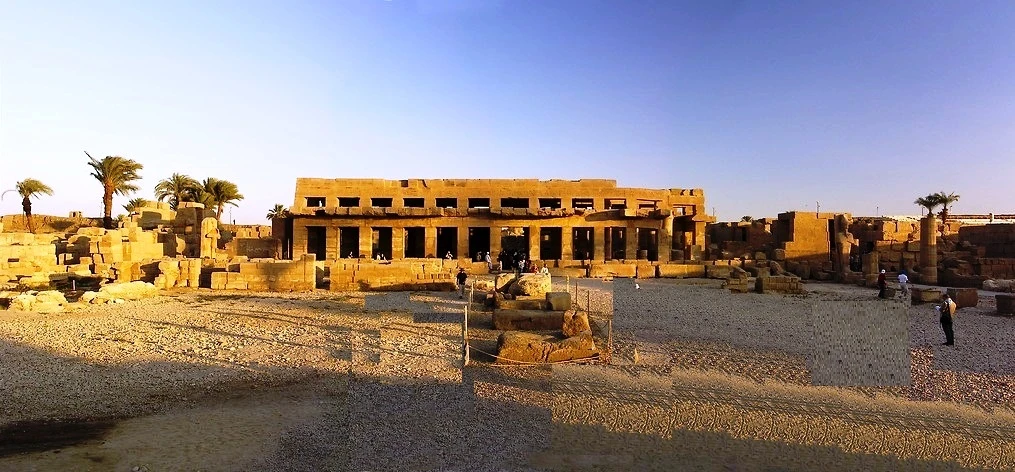

The temple complex of Karnak, dedicated to the Triade of Amun, was the center of his worship and of his wife Mut and their son Khonso. Each of them had a dedicated area in the temple complex, the greatest and largest belonging to Amun. There was also a precinct for Montu, the falcon-headed local god.
Construction on the Karnak temple complex began in the 16th century BC and continued into the Greco-Roman period - a period of up to 1300 years of construction. Around 30 successive Pharoahs added their own touches to the complex: a new temple, shrine, or pylon, sometimes just simple carved detailed hieroglyphic inscriptions.
When the Pharoah Akhenaton abandoned the traditional worship of Amun and took up the worship of Aten, the sun god, he built a temple to Aten inside Karnak. But after his death, the Theban priests destroyed all signs of Aten worship at Karnak and elsewhere.
The Karnak temple complex is huge, covering a site almost a mile by two miles in area. There are over 25 temples and chapels in the complex, including separate shrines for the three boats that took the statues of the gods on their annual trip on the flooding Nile. Sanctuaries, Obelisks, and groups of columns all feature accounts of the heroic deeds of the sponsoring Pharoah.
The key difference between Karnak and most of the other temples and sites in Egypt is the length of time over which it was developed and used. Approximately 30 pharaohs contributed to the buildings, enabling it to reach a size, complexity and diversity not seen elsewhere. The Karnak complex includes several of the finest examples of ancient Egyptian design and architecture. Among them are the Hypostyle Hall, considered one of the world’s great architectural achievements. It is filled with 134 enormous columns, the highest 21M tall, and each about 13.7M around. The hall covers an area of 19685 sqm.
The most spectacular of the temples at Karnak is the Temple of Amun (Amun’s Precinct), the only section open to the public. This is entered via the Avenue of the Sphinxes, or Sacred Way, that once stretched the two miles from Karnak to Luxor Temple.
The Obelisk of Thutmose I, a 22m monument, is the only one of four original obelisks that is still standing in his original place.
at the most inner part of the temple there is the Sancta Santurum decorated by the figures of Alexander the Great dedicating both the chaple and the offers to the great Amun-Ra.
In Egitto, le festività pubbliche sono un vivido riflesso della ricca storia e della diversità culturale del paese. Tra le più importanti vi sono le celebrazioni islamiche come il Ramadan, Eid al-Fitr e Eid al-Adha, che sono momenti di preghiera, riflessione e festeggiamenti in famiglia. Altre festività includono lo Sham el-Nessim, che segna l'arrivo della primavera, e le celebrazioni nazionali come il Giorno della Rivoluzione e il Giorno delle Forze Armate. Queste occasioni offrono agli egiziani l'opportunità di riunirsi e celebrare la loro identità e i valori condivisi.
Yes, it is a custom in Egypt as who works in tourism field expects a tip as an appreciation for the good service he offered.
Kindly refer to our Visa section in "About us" .
For the International flight it will be according to the type booking policy , & concerning the Internal flight you can have just 1 piece with maximum of 20 kilograms (international dimensions).

